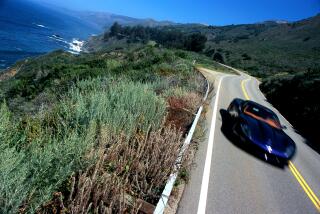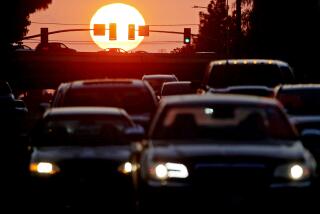Community Essay : The Riddle of Our Roadside Pyramids : What strange magnetism pulls traffic to a crawl at freeway construction sites? And can we ever free ourselves of it?
- Share via
You are driving down a typically busy freeway. It’s rush hour, but traffic is flowing smoothly. You eagerly await the moment when you will reach your off-ramp, drive those last few stretches of suburbia and glide into that familiar garage. Home sweet home.
But it is not to be that easy. The traffic is slowing even now. You are crawling. You stop. You go. In the time it takes to inch a mile, you could have microwaved a turkey. And then it appears, beyond the freeway’s shoulder. The reason for this nightmare.
It’s Big Piles of Dirt.
You creep ahead, awaiting your turn to go past them. You are fascinated by these earthen monsters. You must slow down to pay them homage. You’ve forgotten all about how it will feel to get home, eat, watch “Roseanne.” All that matters is the Dirt . . . the Dirt . . . the Dirt.
Drivers commonly cause jams by rubbernecking at accidents. How much worse are the Big Piles of Dirt (BPD) that we encounter daily? Can the spell of BPD be broken?
It is imperative that we try. But to succeed, we must understand the BPD and our complex relationship with them. Three major theories vie for supremacy.
The first is the Sandbox Theory. It supposes that unfulfilled childhood yearnings are responsible for a fascination with dirt. As Freud might ask, did our mothers call us in too early, just when we were really starting to have fun? Did they reject our mud pies? Was bath time traumatic?
(An adjunct to the Sandbox Theory suggests that the BPD echo an unconscious and unsatisfied Oedipal hunger. Indeed, the BPD may represent a Jungian archetype of motherhood. This corollary is known as the Mound Fixation Hypothesis and is, not surprisingly, highly controversial, especially in feminist circles.)
In any case, proponents of these beliefs say that we must resolve our latent needs if we are to drive the freeways as adults.
The second theory is based loosely on archeological concepts. There is no doubt that the BPD eerily resemble Indian mounds and the pyramids of Central America and Egypt. These antiquarian structures were built for astronomical, cultural and ceremonial purposes. Perhaps the BPD are signs of a civilization that flowered in our midst, long ago, before disappearing. (Can it be a coincidence that Hollywood is known as “Babylon”?)
According to this theory, which we may label the Grassy Knoll Postulate, we hearken to the BPD as our ancestors did, worshiping their majesty and symbolic might. Experts tell us that mound worship may be the earliest form of religion. Evidence of this survives in our pursuit of “pyramid power” and “the perfect slope.”
The third theory is more cosmological in nature (and a little far-fetched, but we should not preclude any possibility in our quest for truth). This is the theory of the Big Piles of Dirt of the Gods (BPDOTG). Every day we see these huge mounds of earth and wonder: Where did they come from? What forces deposited them thus? Is some “invisible hand” at work in our midst, sculpting terra firma with its vast power? Could the BPD be a sign from ancient astronauts reaching to us from the past? A message from a more advanced race? Are the BPDOTG telling us to slow down, to see that our fast-paced, workaholic life-styles are harmful? Are they suggesting that society is collapsing under its own technology-burdened weight?
Admittedly, all of these theories are impossible to prove. But if we think about them long enough and deeply enough, we will find the meaning of the BPD enigma within ourselves. Then we will be free to keep our eyes on the road and our minds on what’s really important: dinner.


